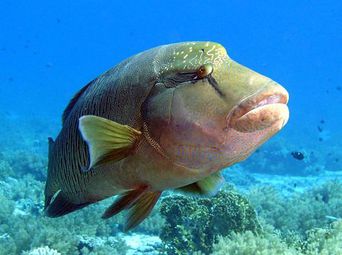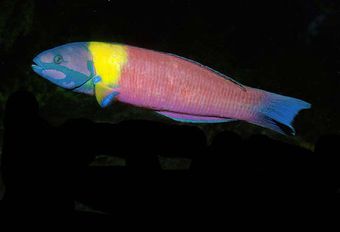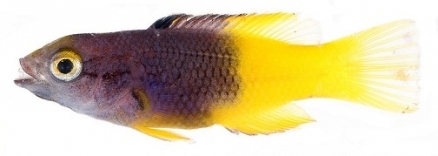Wrasses (Biodiversity)
Contents
Wrasses
Wrasses (the family Labridae) are the most abundant and conspicuous fishes on tropical reefs around the world. Wrasses also comprise an important element of the coldwater fish population on temperate reefs. They are second largest family of marine fishes and the third largest family in the Perciformes order, containing approximately 60 genera and roughly 500 species.
Wrasses appear in a diverse range of colors, shapes, and sizes, often varying considerably within individual species. This morphological diversity is matched by the wide variety of prey consumed. Wrasses fill the roles of piscivores, zooplanktivores, molluscivores, herbivores, planktivores, polychaete predators, decapod crab predators, and coral predators, as well as many others. Many wrasses are organized into harem-based social systems and hermaphroditism is common. Finally, as suggested by their diverse food habits, wrasses fill many important ecological roles on reefs of tropical and temperate regions around the world.
Morphology
 Humphead wrasse (Cheilinus undulatus). Source: Patryk Krzyzak Most wrasses are quite small, usually below 20 centimeters in length. The smallest species, the Minute wrasse (Minilabrus striatus) of the Red Sea, reaches a maximum length of only 4.5 centimeters. The genera Pseudocheilinus and Doratonotus contain several other dwarf wrasses. One species, the Mutant wrasse (Conniella apterygia), is so small that it lacks even pelvic fins and a supporting skeleton. The largest wrasse, Humphead wrasse (Cheilinus undulatus also known as the Napoleon wrasse), can reach a length of about 2.3 meters and weighs more than 150 kilograms.
Humphead wrasse (Cheilinus undulatus). Source: Patryk Krzyzak Most wrasses are quite small, usually below 20 centimeters in length. The smallest species, the Minute wrasse (Minilabrus striatus) of the Red Sea, reaches a maximum length of only 4.5 centimeters. The genera Pseudocheilinus and Doratonotus contain several other dwarf wrasses. One species, the Mutant wrasse (Conniella apterygia), is so small that it lacks even pelvic fins and a supporting skeleton. The largest wrasse, Humphead wrasse (Cheilinus undulatus also known as the Napoleon wrasse), can reach a length of about 2.3 meters and weighs more than 150 kilograms.
Wrasses are most easily identified by their pointed snouts and prominent canine teeth in the front of the jaws, which often project forward. Wrasses characteristically have a protractile mouth and a single continuous dorsal fin lacking an obvious notch between the soft and spiny portions. The lateral line may be continuous or interrupted. Wrasses display a myriad of colors and shapes. Some wrasses are elongate and laterally compressed while others are large and stocky. However, most are elongate and tapered at both ends, often referred to as “cigar-shaped.”
Often, there is considerable diversity of colors and shapes within individual species. As in the parrotfishes (Scaridae), some wrasses progress through “phases", and each phase corresponds with a change in morphology (shape and color). Dominant males (and sometimes females) are the most distinctly colored, with complex patterns of red, yellow, green, blue and black. Subordinate males and females are smaller than dominant individuals and are often drab-colored with cryptic patterns. Juveniles range in coloration from bright yellow and orange to drab gray and brown, and some have camouflaging patterns. Some wrasses exhibit sexual dimorphism.
Distribution
Wrasses occupy all tropical seas and penetrate considerable distances into temperate waters, reaching as far north as Norway. Many temperate species in the genera Oxyjulis, Tautoga, Tautogolabrus, Semicossyphus, and Labrus can be found in both the Atlantic and Pacific Oceans. Wrasses are most highly concentrated off the coasts of Australia where about 165 species and 42 genera are represented.
Habitat
Wrasses can be found in a wide variety of habitats, such as tidal pools, grass beds, rocky or coral reefs, or open sand bottoms. Many wrasses prefer specific environments. Some wrasses prefer turtle grass beds, mixed turtle grass and sandy patch area, or weed-covered rocky flats. Plankton feeders, such as Clepticus, often concentrate in large schools at reef fronts, reef gaps, or other areas where plankton is concentrated in the water column. However, some species, such as the Slippery dick (Halichoeres bivittatus), can be found in a broad range of habitats.
Feeding Behavior
Many wrasses are specialized and voracious feeders, as reflected by the highly variable skull and body shape, modified pharyngeal jaw, and prominent canines. The type of nourishment ranges widely: fish, ectoparasites, mollusks, polychaete worms, decapod crabs, corals, coral mucous, amphipods, various echinoderms, plankton, and several types of vegetation. Many small wrasses follow larger fishes and exploit any benthic (reef bottom) disturbances that help to reveal the well-camouflaged invertebrates. A considerable number are plankton feeders, forming schools in reef gaps, reef fronts or other areas with current.
The food habits of Labroides are probably most well known. Labroides remove mucous, parasites and scales from the bodies of larger fishes. Cleaning is not limited to the Labroides genus however; young Bluehead (Thalassoma bifasciatum) and young Spanish hogfish (Bodianus rufus) in the Bahamas have also been observed cleaning larger fishes. Finally, some piscivorous (fish-eating) wrasses mimic harmless fishes.
Behavior
A characteristic feature of wrasses is their form of propulsion, which relies almost entirely on the pectoral fins. In what is termed “pectoral fins only” propulsion or labriform locomotion, the fish bounces through the water column using the pectoral fins and the caudal fin (tail) is only used when a burst of speed is needed. Wrasses are also strongly diurnal (only active during the daytime) and, like Scaridae, many bury themselves in the sand or seek crevices to hide in at night. Interestingly, observations of wrasses in captivity seem to suggest a rapid eye movement (REM) stage while sleeping. REM sleep is usually associated with dreaming in “higher” vertebrates.
Wrasses may forage individually, in pairs, or in large schools depending on the species. Most wrasses rely on vision to find their prey.
Many juvenile wrasses are cryptically colored to avoid predation while others find protection among the tentacles of sea anenomes (Actinaria). Nearly all adult wrasses bury themselves in sand at night to avoid predators. A few species seek out reef crevices and produce a foul-smelling mucous bag to deter predators while sleeping.
Razorfishes (Hemipteronotus, Xyrichtys) also use the sand for protection during the day by diving into the bottom. Razorfishes are apparently quite agile in this environment, sometimes resurfacing several meters from the point of entry.
Reproduction
Like parrotfishes, many wrasses utilize some of the most complex and unusual reproduction systems known to fishes. Males can be either primary (born male), or secondary (females that have undergone sex change). In some species there are no secondary males while in others all individuals are born female (monandric) and change sex when necessary. In the most complex systems, species are diandric – both primary and secondary males exist in the population. In these species, individuals proceed through three distinct phases, marked by color differences. In fact, the color differences are so pronounced that for over 200 years researchers regarded some phases as distinct species.
Sexually immature juveniles represent the first phase. The second, known as the initial, phase (IP) can include sexually mature males or females, which are impossible to tell apart without internal examination or observation during spawning. IP males and females may group spawn in some species. The terminal phase (TP) includes only mature males, which display brilliant colors. TP males usually dominate reproductive activity through a harem-based social system. The death of a TP male serves as a social cue for an IP female to change sex and behavior. The morphology of IP males may also change in response to the death of a TP male.
In some cases, IP males attempt to fertilize IP females by following a TP male and IP female pair during spawning. In this behavior, called “streaking,” IP males follow the pairs at peak spawning and release a large cloud of gametes in an attempt to overwhelm fertilization by the TP male. This is thought to increase the fecundity (ability to produce offspring) of IP males. IP males are well equipped to perform streaking as they have larger gonads and so are able to produce more gametes, while TP males have smaller testes and rely on aggression to deter other males. The larger volume of milt (gametes) produced by IP males is related to group spawning events with IP females, in which competition for fertilization is intense and more milt is needed.
Some specific examples of wrasse mating systems demonstrate the complexity and variation of the phase system described above. For instance, the cleaner wrasse, which is monandric (all individuals are born female), forms harems that are held together by male aggression towards subordinate females. With the death of the dominant male, subordinate females jockey for position and the newly dominant female adopts aggressive male behavior within a few hours. Each individual moves a step up in the dominance hierarchy and the last position is filled by a juvenile. If the newly dominant female is able to withstand attempts by neighboring males to take over the vacant harem, she will become a fully functional male within a two to four days.
Some other harem-forming species are Cirrhilabrus temminckii, Cirrhilabrus jordani, Labroides bicolor, Hemipteronotus splendens, Pseudocheilinus hexataenia and Macropharyngodon moyeri. The Caribbean species Halichoeres garnoti is also monandric, but individuals do not exhibit territoriality or conspicuous dominance relationships, nor do they use aggressive actions to maintain sexual state. Instead, size or some size-related factor determines which individual will fill the male role. In Halichoeres garnoti males are larger than females and both sexes behave similarly. While these examples focus on the mating extremes of wrasses, most species fall between the systems of the cleaner wrasse and Halichoeres garnoti in terms of the influence of social control on sex reversal. Other hermaphroditic but non-harem-forming species include Halichoeres bivittatus and Halichoeres poeyi, Halichoeres maculipinna and possibly Thalassoma lunare.
Finally, some species, such as Oxyjulis californica and Crenilabrus melops, do not follow the phase system at all as they are not hermaphroditic, and there are probably more non-hermaphroditic species yet to be found.
In tropical wrasses spawning occurs year-round but some temperate species seem to restrict spawning to warmer parts of the year. Spawning typically occurs along the outer edge of patch reefs or along the outer edges of more extensive reef complexes. The correlation between spawning and lunar periodicity (the lunar cycle) is sketchy in some species and non-existent in most that have been investigated. Spawning in several species corresponds with outgoing tides, however, many species spawn at a particular time in the day, regardless of tidal patterns. This variation may be due to local conditions. For instance, in areas where tidal forces are weak, factors like time of day or light intensity may have more influence. However, evidence from different species on the same reef suggests that temporal (measured time) differences in spawning evolved to decrease the probability of hybridization with other species.
 Cortez rainbow wrasse (Thalassoma lucasanum). Source: Encyclopedia of Life/Smithsonian Tropical Research Institute Wrasses may spawn in groups or pairs depending on the species or phase of individuals. Typically, group or aggregate spawning occurs between initial phase (IP) individuals, which are diandric (containing male and female IP individuals). However, in some species, such as Thalassoma cupido, Thalassoma lucasanum, and Halichoeres bivitattus, terminal phase (TP) males have been observed participating in group spawning. The size of the spawning groups ranges from a dozen to several hundred individuals. Males outnumber females, sometimes by as much as ten to one. Paired spawning is found in many, if not all, tropical wrasses and involves a TP male and IP female. In rare cases, IP individuals also spawn in pairs. Most species defend small territories only during spawning. Currently Anampses cuvieri is the only known species of tropical wrasse to produce demersal eggs (eggs laid on the bottom as opposed to being released in the water column). Demersal spawning of Anampses cuvieri was only observed in captivity and still needs to be confirmed, but work on other species of this genus seems to support this observation.
Cortez rainbow wrasse (Thalassoma lucasanum). Source: Encyclopedia of Life/Smithsonian Tropical Research Institute Wrasses may spawn in groups or pairs depending on the species or phase of individuals. Typically, group or aggregate spawning occurs between initial phase (IP) individuals, which are diandric (containing male and female IP individuals). However, in some species, such as Thalassoma cupido, Thalassoma lucasanum, and Halichoeres bivitattus, terminal phase (TP) males have been observed participating in group spawning. The size of the spawning groups ranges from a dozen to several hundred individuals. Males outnumber females, sometimes by as much as ten to one. Paired spawning is found in many, if not all, tropical wrasses and involves a TP male and IP female. In rare cases, IP individuals also spawn in pairs. Most species defend small territories only during spawning. Currently Anampses cuvieri is the only known species of tropical wrasse to produce demersal eggs (eggs laid on the bottom as opposed to being released in the water column). Demersal spawning of Anampses cuvieri was only observed in captivity and still needs to be confirmed, but work on other species of this genus seems to support this observation.
Some temperate wrasse species, such as the ballan wrasse, Symphodus ocellatus and Anampses cuvieri, are demersal nest builders. The nests are usually made out of plant material and the male guards the eggs after they are deposited. (Thresher, 1984; Wheeler, 1985)
Visual recognition may also be important for terminal phase (TP) males to identify harem members. Although TP males are susceptible to streaking attempts by initial phase (IP) males, no IP males have been found in harem-forming species. This suggests that IP males are unable to mimic IP females, despite very similar morphology.
No information was found concerning the lifespan of wrasses but, in general, reef species live between three and five years. (Moyle and Cech, 2000)
Associations
The ecological role of Labroides of the Indo-Pacific region provides a good example of the complexity of seemingly mutualistic relationships between fishes. Typically, cleaner fishes are elaborately colored and perform displays over a patch of reef while larger fish approach and assume a relaxed posture. Cleaner fishes are commonly thought to benefit the host by removing dead or damaged tissue and ectoparasites. Accordingly, investigators reported higher recovery rates for wounded fish in the presence of cleaners. However, in experiments where all cleaners were removed from an environment there was no incidence of fishes leaving the area or becoming particularly unhealthy. Further, when levels of parasitic infections are high the host benefits from cleaning but when infection levels are low, which they usually are, some cleaners feed on healthy tissue, such as scales, pieces of fin, mucous, or in some cases the eggs of other reef fishes. Despite these parasitic qualities of the relationship, fishes being cleaned have a positive response to the tactile stimulation from cleaners, suggesting that some cleaners are mildly beneficial while others have taken advantage of the cleaning arrangement.
The relationship between wrasse species and their invertebrate prey is a spectacular example of coevolution. As invertebrates have developed anti-predator adaptations, such as spines, toxins, heavy armor, and adherence to the substrate, wrasses have evolved simultaneously. Some physical changes include the development of strong, hard beaks and a second set of strong teeth in the throat (pharyngeal jaw), making it possible to crush hard-shelled invertebrates. A conspicuous behavioral adaptation is “following behavior.” As larger fish disturb the substrate, some wrasses follow close behind to capture exposed invertebrates. Other small wrasses have become adept at combing the reef for invertebrates too small for most fishes to prey upon. Finally, some wrasses use their snouts to flip rocks and pieces of coral, or more rarely, pick them up in their jaws,to expose hidden invertebrates.
Conservation Status
Sixteen labrid species are listed as vulnerable: Achoerodus gouldii,Bodianus scrofa, Conniella apterygia,Coris bulbifrons,Halichoeres adustus,Halichoeres discolor,Halichoeres insularis, Halichoeres malpelo, Halichoeres salmofasciatus, Labrus viridis, Lachnolaimus maximus, Thalassoma robertsoni, Thalassoma virens, Xyrichtys victori, Xyrichtys virens, and Xyrichtys wellingtoni.
References
- Enctclopedia of Life. 2012. Labridae (Wrasses).
- Böhlke, J., C. Chaplin. 1984. Fishes of the Bahamas and Adjacent Tropical Waters. Wynnewood, Pa: Published for the Academy of Natural Sciences of Philadelphia by Livingston.
- Choat, H., D. Bellwood. 1998. Wrasses & Parrotfishes. Pp. 209-213 in W Eschmeyer, J Paxton, eds. Encyclopedia of fishes – second edition. San Diego, CA: Academic Press.
- Fautin D, Dalton P, Incze LS, Leong J-AC, Pautzke C, et al. 2010. An Overview of Marine Biodiversity in United States Waters. PLoS ONE 5(8): e11914.
- Helfman, G., B. Collete, D. Facey. 1997. The Diversity of Fishes. Malden, MA: Blackwell.
- Moyle, P., J. Cech. 2000. Fishes: An introduction to ichthyology – fourth edition. Upper Saddle River, NJ: Prentice-Hall.
- Myers, P., R. Espinosa, C. S. Parr, T. Jones, G. S. Hammond, and T. A. Dewey. 2006. The Animal Diversity Web
- Nelson, J. 1994. Fishes of the World – third edition. New York, NY: John Wiley and Sons.
- The World Conservation Union, 2012. The IUCN Red List of Threatened Species 2012.1
